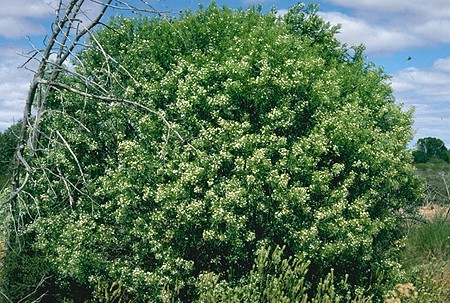
Synonymy
Duboisia myoporoides R.Br., Prodr. 448 (1810)
T: Port Jackson, N.S.W., R.Brown s.n.; syn: BM, K, MEL, NSW, P.
Entrecasteauxia elliptica Montr., Mém. Acad. Roy. Sci. Lyon, Sect. Sci. ser. 2, 10: 244 (1860).
T: `In sylvis Art', Montrouzier s.n.; ?P, n.v.
Description
Tall shrub or tree to 24 m; bark thick and corky towards base.
Leaves narrowly obovate to narrowly obovate-elliptic, occasionally narrowly elliptic, sessile (or with petiole to 3 cm long), 4–15 cm long, 1–4 cm wide, slightly discolorous.
Inflorescence broadly pyramidal; bracts 1–11 mm long; pedicels 2–7 mm long. Calyx 1–3 mm long, the lobes usually one-fifth to one-third as long as tube. Corolla 4–7 mm long; tube 2–4 mm diam. at apex; lobes 1–3.5 mm long. Stamens 4, sometimes 5, 1.5–3 mm long. Style 1–2 mm long, slightly shorter to longer than upper stamens.
Berry usually globose, rarely ellipsoid to ovoid, 4.5–8 mm long, purple-black; fruiting pedicels 6–12 mm long. Seeds 2.3–3.1 mm long.
Distribution and ecology
Occurs in eastern Australia from northern Qld to south-eastern N.S.W.; also native to New Caledonia.
Grows in high rainfall areas in sand or loam, often at rainforest margins or in clearings, or in moist Eucalyptus forest.
Notes
Source of Alkaloids: contains tropane alkaloids; leaves harvested commercially as source of hyoscine for medicinal drugs. Reported to be toxic to cattle, horses and humans.
A history of the use of Duboisia myoporoides as a source of alkaloids has been published by Paul Foley in Historical Records of Australian Science 17: 31-69 (2006). This comprehensive review also considers the different forms of alkaloids and their nomenclature.[rmb]
Hybridisation: known to hybridise with Duboisia leichhardtii (F.Muell.) F.Muell.
Cyphanthera frondosa Miers and C. cuneata Miers are both names which refer to possible hybrids between D. myoporoides and Cyphanthera albicans (A.Cunn.) Miers while Anthocercis tenuipes Gand. is possibly a hybrid between this species and C. scabrella (Benth.) Miers.
Derivation of epithet
From Latin: the addition of -oides means "resembling", hence in this case "resembling Myoporum", presumably a reference to a perceived likeness to that genus.
Images and information on web
Further information and images of this species in NSW can be seen on the PlantNET site.
An unpublished manuscript by Paul Foley, Prince of Wales Medical Research Institute,
A fact sheets on the effects of ingestion of D. myoporoides on animals can be downloaded from the Australian Weeds and Livestock pages dealing with the effects of plants on various farm animals.
References to the possible toxic properties of Duboisia species can be found with a search in the FDA Poisonous Plant Database
A discussion of the tropane alkaloids which occur in Duboisia and other Anthocercideae can be found in Griffith & Lin (2000).
Ref: W.J. Griffin & G.D. Lin (2000). Chemotaxonomy and geographical distribution of tropane
alkaloids. Phytochemistry 53: 627–628.
The detailed image of D. myoporoides from Koehler's Medicinal-Plants (1887) can be accessed under “Corkwoodtree” at http://pharm1.pharmazie.uni-greifswald.de/allgemei/koehler/koeh-eng.htm and another can be accessed in Grieve's Modern Herbal at www.botanical.com/botanical/mgmh/c/corkw100.html






